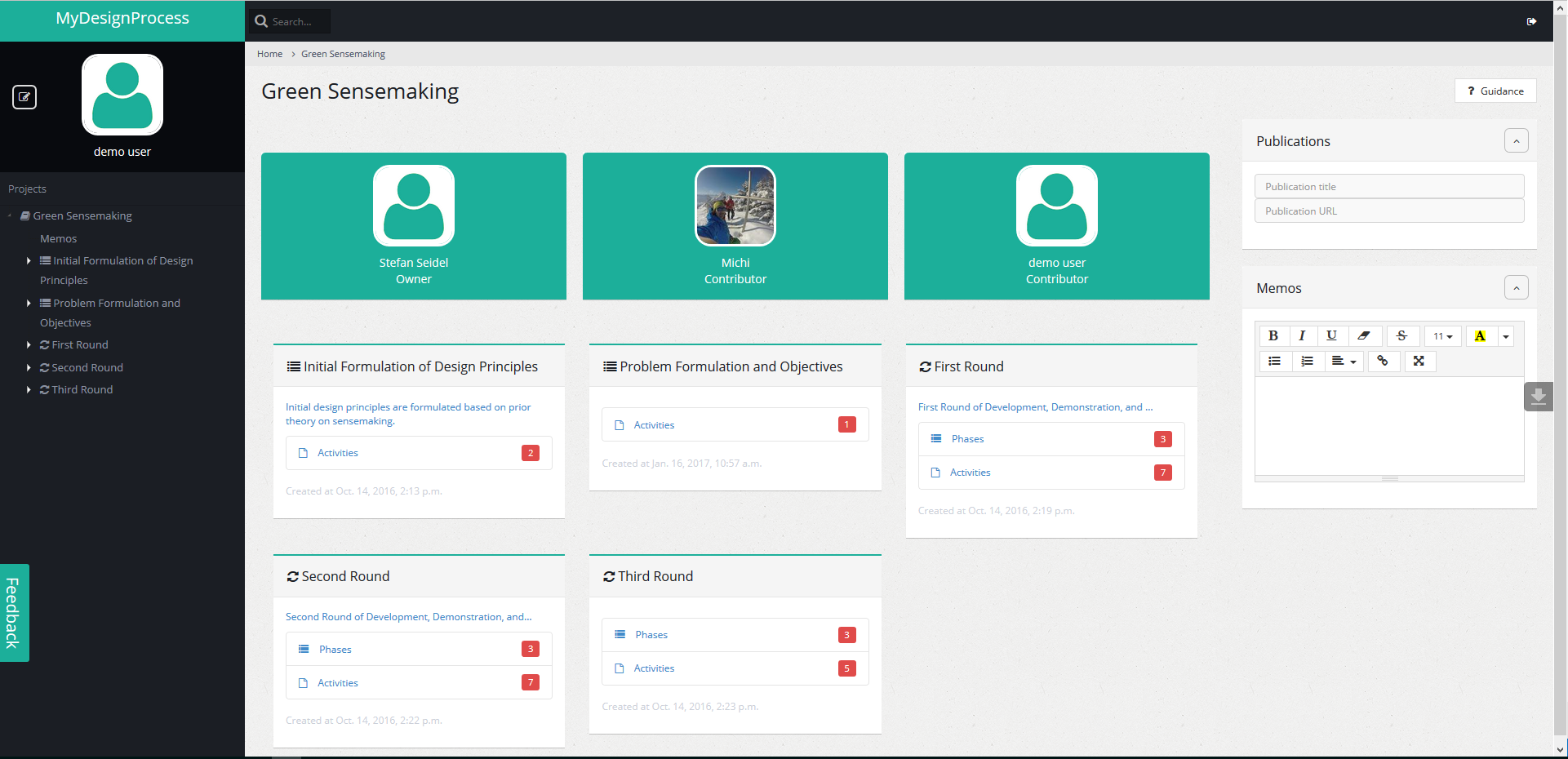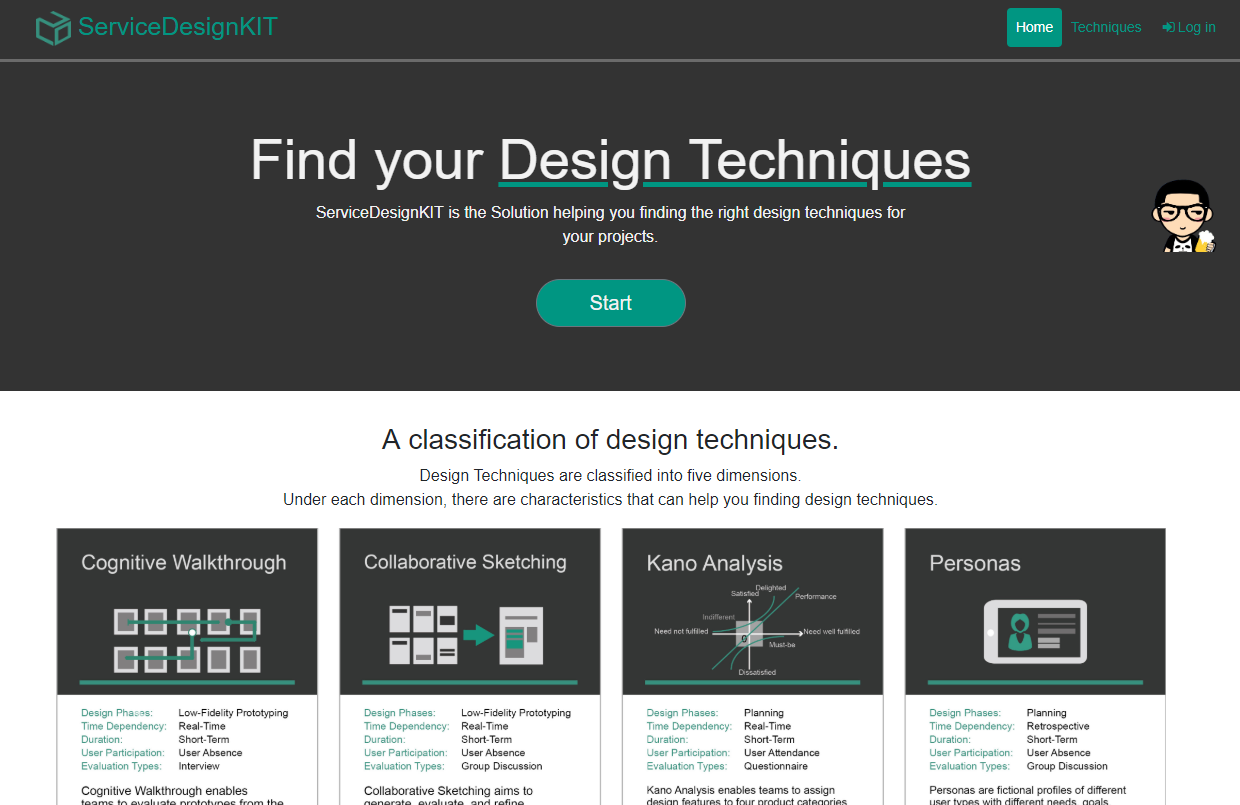Prototypes from Research Projects
MyDesignProcess: Tool-Support for Design Processes |
Design Science Research (DSR) is now an accepted research paradigm in the Information Systems (IS) field, aiming at developing purposeful IT artifacts and knowledge about the design of IT artifacts. A rich body of knowledge on approaches, methods, and frameworks supports researchers in conducting DSR projects. While methodological guidance is abundant, there is no dedicated software solution that supports researchers in applying this guidance, and in structuring and managing their DSR projects. We developedMyDesignProcess.com, a web-based DSR project tool that enables researchers and teams of researchers to structure, document, maintain, and present their DSR projects, including the resulting design knowledge and artifacts. The tool is aimed to increase traceability, collaboration, and quality in DSR projects. |
Entwurf einer innovativen, nutzer-basierten Vereinsverwaltungssoftware für non-profit Sportorganisationen |
Im Rahmen des vom Bundesministerium für Wirtschaft und Energie geförderten Projektes Kompetenzzentrum Usability wurde aufbauend auf einer groß-angelegten Nutzeranalyse in Kooperation mit der CAS Software AG eine Vereinssoftware für Sportvereine, die den gesamten Bedarf für Sportvereine abdeckt und sie per self-service zugänglich macht, konzipiert. |
ServiceDesignKIT |
ServiceDesignKIT (servicedesignkit.org) can be used as a filter for the selection of design techniques under different design situations. The top-down classification and the natural language UI can help people select design techniques. Users are also enabled to bottom-up suggest design techniques. This web-based platform has been used as a tool for searching design techniques in our digital service design lecture. |
KeyPro: A Software Tool to Automatically Discover the Process Landscape of a Company from Enterprise Resource Planning Systems |
Companies consist of hundreds of business processes – many of them unknown to managers. Thus, prioritization is essential for process decision-making in projects, investment decisions and resource allocation, monitoring, improvements and many more. Further, organizational decision-makers frequently do not have clear perceptions of which processes are of prime and secondary importance, or which processes exist in an organization at all. Further, research does not provide a satisfactory definition of process importance and quantifiable proxies. Thus, this project derives dimensions of process importance including the number of process executions, involved process stakeholders, customer or supplier involvement, and value chain position from literature, and introduces measurable proxies from information systems for each dimension. “KeyPro” is developed to explore important processes bottom-up from log data in SAP ERP systems with visualization in interactive dashboards. |
Business Model Miner: A Software Tool to Mine Business Models from Enterprise Resource Planning Systems |
Organizations navigate in increasingly dynamic business environments. In response, organizations require high-velocity and data-driven decision-making for the transformation of business models to realign with the environment. Traditional top-down approaches to business modelling such as the “Business Model Canvas” (BMC) are human-centric and mostly independent of operational data. To complement the existing top-down approaches to business modelling, this project proposes a data-driven Business Model Mining (BMM) system. The system automatically identifies, retrieves, and visualizes the current business model of an organization from data contained in organizational information systems (IS) such as SAP ERP. We instantiate the Business Model Miner systeml using Microsoft Azure and PowerBI. |
Human-Like Chatbots in Customer Service
|
In our research in the field of chatbots (see |
ServiceDesignKIT: Design Techniques Selection and Application Support
|
ServiceDesignKIT provides a comprehensive overview of existing design techniques for digital services and supports their selection and application. Each design technique is represented by flipcards including a short description as well as a step-by-step instruction on how to execute it. It combines a top-down taxonomy-based classification and a bottom-up tag-based classification with an interactive search function allowing easy access to the design techniques. ServiceDesignKIT is an open platform allowing people to contribute with comments and add further design techniques. http://www.servicedesignkit.org/
|
Process Guidance Systems in IT-Service Management
|
The following process guidance prototype was developed in the context of a master thesis in cooperation with the company Freudenberg Sealing Technologies. The so called ITSM ProcessGuide supports the employees of the various IT departments in the execution of the IT Ticketing processes. The prototype is used productively at Freudenberg Sealing Technologies and the conducted evaluation confirms the design and the effects on the employees' process knowledge and process execution performance.
|
Usability Diagnosis Tool
|
65% of enterprises mention usability as an important role for selecting the right software for their business. Therefore software companies can bring differentiation benefits by investing in usability. But how successful and effective does your company already turn common usability procedures into reality? The platform below provides a self-test, designed for estimating the usability level of your product.
|
Knowledge Platform for Peer-to-Peer Employee Support |
The WeChange project was funded by the German Federal Ministry of Education and Research as well as the DLR (the German National Aeronautics and Space Research Centre). A decentralized knowledge and support platform targeting the retention of innovation capacity under the influence of demographic change is one result of the project.
|



